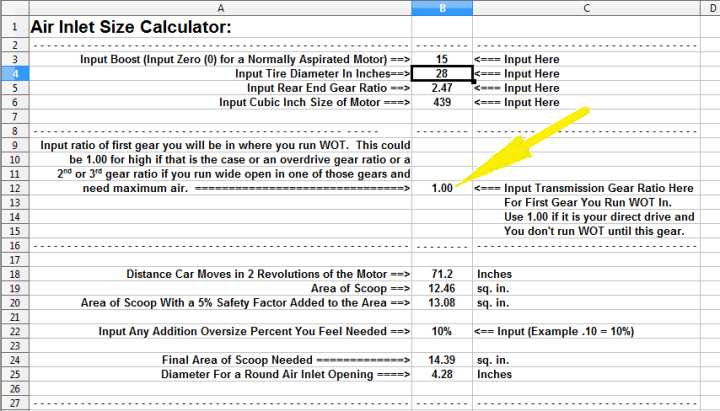I made a change to the spreadsheet I have on my site for figuring the area of an inlet for a scoop. The basis of this spreadsheet isn't my own but was passed on to me some years ago by I believe Tom Burkland. The old spreadsheet figured the inlet size based on the fact that you were using a final transmission gear of 1 to 1 and sized a scoop for WOT in that gear.
We used the formula with success on Hooley's Stude and oversized the opening about 15% for a safety factor using the input where you can oversize by a percentage.
The other day when talking to Tim Cox in Phoenix who runs b'ville and EM the topic of scoop inlet size came up. At El Mirage they don't run top gear so I wanted to make a way that one could size the opening based on the first gear they could run WOT in as that is when they would need the scoop to deliver the required amount of air to the motor.
The scoop inlet air formula isn't based on the speed the car is going as some people assume but on how far the car goes in two revolutions of the motor regardless of what speed that is. The inlet will travel forward so many inches (feet, meters) for each 2 revolutions of the engine. That distance will be determined by the circumference of the tire and the rear end ratio only when in a transmission gear that is 1 to 1. The formula in my spreadsheet and other's have only used those two inputs based on the fact that high gear is most likely 1 to 1 and that is also the gear you can finally achieve WOT on the salt in most cases. Knowing the distance the scoop travels and the air requirements of the engine based on the cubic inch size and if it is naturally aspirated or blown we can figure the area of the opening so that as the car moves forward the scoop will take in a column of air equivalent to what the engine needs.
Why do we want to do this? Imagine going down the highway at speed and holding a cup out the window with the open end in the air stream. It is going to take some effort to hold onto it. Now cut the bottom out and hold the cup in the air stream. Easy now as the air will flow through it. That is what we are looking for. We want the engine to consume the air that is coming in the front of the scoop so that the opening is not an obstruction to the air stream. If the scoop is too large and the engine can't consume it that air will pile up like in the cup with the bottom and then have to divert and go around the scoop opening in a turbulent manner causing drag. Of course it is going to be impossible to achieve 100% consumption at all speeds and throttle openings so the scoop opening is always going to cause some drag. The less it does, especially as the car reaches maximum speed, the faster the car should be as it has less drag from this part of the car.
Most people's gut tells them that these scoop openings are too small after seeing the big bug catchers and others that are on drag cars. Those cars need the big opening to not choke the engine at lower speeds, but they also have the traction to use full power at much lower speeds than a car on the salt with skinny tires can. Those big bug catchers and other scoops with large openings can hurt a land speed car though and not help it as the big HP won't work off the line and in most cases until very high speeds are reached.
With the Stude we can't run WOT until the end of 3rd gear (in our case our 1 to 1 gear) and run WOT in 4th, an overdrive gear in our case so the spreadsheet is pretty good in our case. What if you can run WOT in a gear that is lower or higher than 1 to 1 and need the scoop to supply the appropriate amount of air?
The change I made to the spreadsheet....

....now lets you input the gear ratio of the gear where you start to run WOT so that you will have the air the engine needs at that point. You input that ratio where the arrow is pointing. (Note: if the engine doesn't get the air it needs in most instances that only hurts HP as the motor is running rich, not lean)
Above I inputted data for a fictional B motor running 15 lbs of boost (put a zero in that line for a NA motor) with a 28 inch tire and a 2.47 rear gear and a 1 to 1 gear where the car would be running WOT. Note the scoop only needs a frontal area of about 13 sq. in. and that is for a blown motor.
The spreadsheet also helps you build a rectangular scoop with rounded ends ...

... and lets you input a desired height. In this example I inputted 2 inches for the height and it gave me a center section that is 2 X 5.63 with rounded ends that have a 2 inch diameter.
If I wanted to size for say 3rd gear or an overdrive gear I'd input that gear ration where the arrow is in the first picture.
This spreadsheet along with others of possible help can be found here...
http://purplesagetradingpost.com/sumner/bvillecar/bville-spreadsheet-index.html...once downloaded 'save' the spreadsheet and then open it and you should be able to input data into it.
Hope this helps someone and feel free to make comments,
Sum